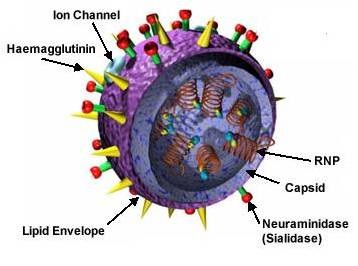
- HA encodes hemagglutinin (about 500 molecules of hemagglutinin are needed to make one virion). This protein determines the extent of infection into host organism, bronchial epithelial cells, lungs and other organs.
- NA encodes neuraminidase (about 100 molecules of neuraminidase are needed to make one virus particle).
- NP encodes nucleoprotein encapsidating the negative strand viral RNA.
- M encodes two matrix proteins (the M1 and the M2, which is an ion channel) by using different reading frames from the same RNA segment (about 3000 matrix protein molecules are needed to make one virion).
- NS encodes two distinct non-structural proteins (NS1 and NEP) also by using different reading frames from the same RNA segment.
- PA encodes an RNA polymerase.
- PB1 encodes an RNA polymerase and PB1-F2 protein (induces apoptosis) by using different reading frames from the same RNA segment.
- PB2 encodes an RNA polymerase.
Take a look at the BLAST results of 8 NA sequences coding for the protein targeted by drugs oseltamivir (Tamiflu) and zanamivir (Relenza). Perfect alignment to european swine flu sequences, minimal variations. The bird viruses come second best. Taking into account that bird flu easily developed resistance to the above mentioned drugs, and that vaccine development will be a challenge, this does not sound too good.

CDC expects we will see more deaths. From a historical perspective, this is, indeed, scary: Asian Flu pandemic of 1957 and the Hong Kong Flu pandemic of 1968 occurred as a result of influenza mutated by antigenic shift, recombination similar to the one observed for current swine flu outbreak. Missense mutations account for other milder epidemics (1962, 1964, etc). The human swine flu outbreak continues to grow in the United States and internationally. So is it going to be a Worldwide Pandemic or a Case of the Sniffles? Let’s hope for the best, but prepare for the worst.

 RSS Feed
RSS Feed
